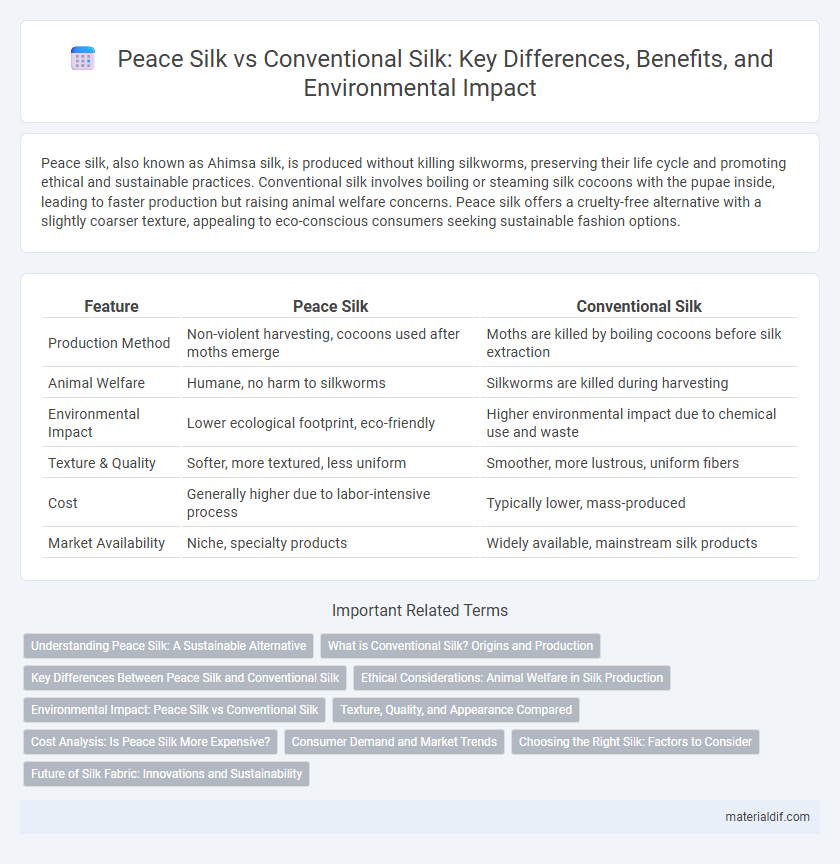Peace silk, also known as Ahimsa silk, is produced without killing silkworms, preserving their life cycle and promoting ethical and sustainable practices. Conventional silk involves boiling or steaming silk cocoons with the pupae inside, leading to faster production but raising animal welfare concerns. Peace silk offers a cruelty-free alternative with a slightly coarser texture, appealing to eco-conscious consumers seeking sustainable fashion options.
Table of Comparison
| Feature | Peace Silk | Conventional Silk |
|---|---|---|
| Production Method | Non-violent harvesting, cocoons used after moths emerge | Moths are killed by boiling cocoons before silk extraction |
| Animal Welfare | Humane, no harm to silkworms | Silkworms are killed during harvesting |
| Environmental Impact | Lower ecological footprint, eco-friendly | Higher environmental impact due to chemical use and waste |
| Texture & Quality | Softer, more textured, less uniform | Smoother, more lustrous, uniform fibers |
| Cost | Generally higher due to labor-intensive process | Typically lower, mass-produced |
| Market Availability | Niche, specialty products | Widely available, mainstream silk products |
Understanding Peace Silk: A Sustainable Alternative
Peace silk, also known as Ahimsa silk, is a sustainable alternative to conventional silk produced by allowing silkworms to complete their natural life cycle, emerging from cocoons before the silk is harvested. This ethical method reduces harm to silkworms and supports biodiversity, contrasting with conventional silk production, which typically involves boiling or steaming cocoons with larvae inside. The environmental impact of peace silk is lower, making it a preferred choice for eco-conscious consumers seeking cruelty-free and sustainable textile options.
What is Conventional Silk? Origins and Production
Conventional silk, also known as mulberry silk, originates from the Bombyx mori silkworm, primarily farmed in China and India. Its production involves harvesting silk fibers from cocoons after killing the pupae through steaming or boiling, which ensures long, continuous strands ideal for high-quality fabric. This traditional sericulture process has been practiced for thousands of years and remains the dominant method in the global silk industry.
Key Differences Between Peace Silk and Conventional Silk
Peace silk, also called Ahimsa silk, is produced without killing silkworms, allowing moths to emerge naturally, whereas conventional silk involves boiling cocoons with larvae inside to extract continuous silk fibers. The ethical harvesting method of peace silk results in shorter fibers and a slightly rougher texture compared to the smooth, long fibers of conventional silk. Environmentally, peace silk often supports sustainable farming practices and reduces insect mortality, making it a preferred choice for eco-conscious consumers.
Ethical Considerations: Animal Welfare in Silk Production
Peace silk, also known as Ahimsa silk, prioritizes animal welfare by allowing silkworms to complete their metamorphosis naturally before harvesting the silk, avoiding harm to the pupae. Conventional silk production involves boiling silkworms alive in their cocoons to extract silk threads, raising significant ethical concerns regarding animal cruelty. The shift towards peace silk reflects a growing demand for humane and sustainable textile practices in the fashion industry.
Environmental Impact: Peace Silk vs Conventional Silk
Peace silk, also known as Ahimsa silk, is produced without killing silkworms, resulting in a more ethical and environmentally friendly process compared to conventional silk, which involves boiling the cocoons with larvae inside. This method reduces harm to biodiversity and supports sustainable practices by allowing silkworms to complete their life cycle, while conventional silk production often leads to significant waste and higher resource consumption. Peace silk cultivation generally consumes less water and chemicals, contributing to lower carbon emissions and a smaller ecological footprint.
Texture, Quality, and Appearance Compared
Peace silk offers a softer, more breathable texture compared to conventional silk, which can feel stiffer due to chemical treatments. The quality of peace silk is often considered superior because it is hand-spun and free from harmful processes, preserving the natural sheen and strength of the fibers. In appearance, peace silk has a slightly matte finish that appeals to eco-conscious consumers, while conventional silk boasts a glossier, more lustrous look often achieved through industrial finishing techniques.
Cost Analysis: Is Peace Silk More Expensive?
Peace silk, also known as Ahimsa silk, typically incurs higher production costs due to the ethical practice of allowing silkworms to mature and leave the cocoon naturally, which reduces yield efficiency compared to conventional silk. Conventional silk involves boiling cocoons with larvae inside, enabling faster processing and larger output, resulting in lower market prices. While Peace silk commands premium pricing due to its cruelty-free process and sustainability, consumers must weigh these costs against ethical considerations and environmental benefits.
Consumer Demand and Market Trends
Peace silk, also known as Ahimsa silk, is experiencing increasing consumer demand driven by ethical fashion trends and animal welfare concerns. Market analysis reveals a growth surge as eco-conscious buyers prioritize cruelty-free and sustainable silk options over conventional silk, which involves killing silkworms. Consequently, retailers and brands are expanding peace silk product lines, reflecting a shift towards more humane textile sourcing in the global silk market.
Choosing the Right Silk: Factors to Consider
Peace silk offers a cruelty-free alternative by allowing silkworms to complete their natural lifecycle, making it an ethical choice for consumers sensitive to animal welfare. Conventional silk, produced through boiling silkworms in cocoons, provides a smoother, more lustrous fabric favored for its traditional luxury appeal. When choosing the right silk, factors such as ethical sourcing, texture preferences, environmental impact, and intended use should guide the decision.
Future of Silk Fabric: Innovations and Sustainability
Peace silk offers a sustainable alternative to conventional silk by allowing silkworms to emerge naturally, reducing environmental impact and ethical concerns. Innovations in peace silk production include biodegradable dyes and energy-efficient processing techniques that enhance eco-friendliness. The future of silk fabric lies in combining these sustainable methods with advanced textile technologies to create high-quality, cruelty-free luxury materials.
Peace silk vs Conventional silk Infographic

 materialdif.com
materialdif.com